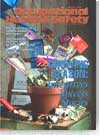
January 2003
Features
By Jerry Laws
Editor's note: Jolanda Janczewski is President and CEO of Consolidated Safety Services Inc., a Fairfax, Va.-based safety and occupational health consulting firm with about 45 employees. CSS was honored in September 2002 as the U.S. Department of State's Small Business Prime Contractor of the Year for on-site testing and decontamination services provided during the October 2001 anthrax episode in the nation's capital. In the following excerpts from a Sept. 19, 2002, conversation with the editors of First Responder, Janczewski discusses the experience and how the safety and emergency response community can prepare for the next crisis.
By David Bruce
WE live in a fast-paced society where the world is virtually at our fingertips 24 hours a day, 7 days a week. The popularity of everything from fast food to video on demand, to gas stations with pay-at-the-pump options, has spoiled us.
By Gregory A. Younger
COMPUTER-based simulation of work experience has proven extremely effective in helping learners achieve their training goals. Simulation increases the learner's involvement and interest in online learning; however, bandwidth limits the forms it can take.
By Spencer Toomey
DURING a shift change, an employee removes his eye and ear protection to chat with the worker taking his place. As he walks away, a machine nearby malfunctions, spraying parts and scalding steam in his direction. He is unable to work for two weeks.
By Lance C. Presley, Ph.D.
IT has only been a few years since laboratory-based oral fluid drug screening first appeared on the menu of choices for employers' substance abuse testing programs. In the beginning, some in the employer drug-testing market were skeptical of the new screening.
By Erin L. Wade
ALL of us have experienced it--that tiny shock we receive when touching a doorknob after walking across a carpeted floor. The shock is the transfer of static charge, or a balancing of our charge to that of the object. This transfer is called Electrostatic Discharge, or ESD. To understand electrostatic discharges, you must first understand the source.
MATERIAL handling carts (also known as utility, hand, or service carts) are used in most manufacturing environments to physically transport goods or parts to other areas of the operation for manipulation, storage, or shipment. Many times, safety and ergonomics professionals will advocate pushing a cart from the back when it has to be moved.
By Larry Wilson
MOST accident/incident investigations tend to look at the injury or incident from an external perspective. In other words, somebody else (typically) investigates the incident or injury, instead of the person who was hurt doing the investigation himself.
By Eric Berezin, Shay Zeemer
IS it an "injury" or an "illness?" Is the broken ankle suffered during the company-sponsored softball game a recordable injury? How should lost work time be recorded? Does that butterfly bandage constitute first aid, or is it medical treatment?
By Larry Bush
FORWARD-looking companies are thinking "leading indicator" rewards when it comes to safety programs, as they strive to make more efficient use of their safety investment. This proactive approach is paying dividends over the old, outcome-based focus.
By Jim Szymanski, RKT
CHAIRS are a common point of debate in today's workplace. The questions most frequently debated derive from the differences between an engineering approach and a therapeutic approach to work injury prevention.
By Fred Elliott
THERE'S a lot of protection contained inside a glove these days. Corrosive or toxic material exposures, cuts, abrasions, and vibration are typical hazards these deceptively simple products ward off for employees.
Departments
By Jerry Laws
NEW sections are rare in this magazine. During my seven years as its editor, just one has launched--Workplace Ergonomics--but it was not new.
By Valerie Weadock
A bruise, a cut, an eye, a finger, a little lost work . . . the costs of a workplace injury can quickly add up. However, construction safety officers and their supervisors daily weigh these costs against the costs of providing their employees with the proper personal protective equipment.
By Lester S. Rosen
Employee lawsuits often will catch companies by surprise. Often, though, a worker's application is a tip-off that the employer is hiring a lawsuit that's just waiting to happen. By looking for these 10 danger signals, an employer can avoid hiring a problem in the first place.